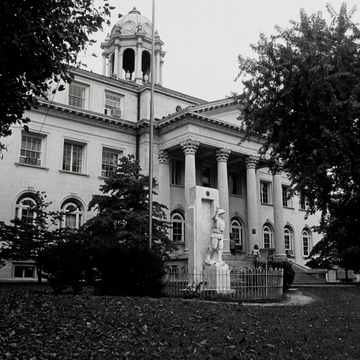This handsome neoclassical structure, Boone County's most important building and one of West Virginia's most architecturally distinguished courthouses, dominates Madison from an acropolis high above a broad lawn. The courthouse is faced with ashlar blocks of Indiana limestone laid in regular courses. A monumental, tetrastyle Corinthian portico graces the west facade. An identical portico fronts the southern elevation, while a screen of engaged columns centers the northern side. Heavy bolection moldings surround the windows. Although the building is a full three stories tall, the third story is treated as an attic above a broad entablature. A nicely scaled, octagonal cupola embellished with engaged columns and a full entablature supports a gilded dome. The main interior space, a second-floor courtroom, is largely unchanged.
Peter Minotti, a native of Italy and a wellknown stonemason and contractor in the southern coalfields, obtained the construction contract but failed to complete the building because of unexpectedly high wages and prices of scarce materials during World War I. Ultimately, the county court replaced him as contractor, and the building was completed five years after it was begun. As finished, it reflected the surge of prosperity that coal brought to the county. Warne, one of West Virginia's bestknown and most accomplished architects, considered this one of his best buildings. Of many structures he designed, it was among the few that were listed in his obituary.
Two statues flank the central stair leading to the courthouse. On the left is a marble World War I doughboy, a grenade in his right hand, a rifle in his left. E. M. Viquesney of Spencer, Indiana, was the sculptor. To the right is Gary Razen's bronze statue of a miner, titled The Sentinel, dedicated to Boone County coal miners on September 2, 1991.




















